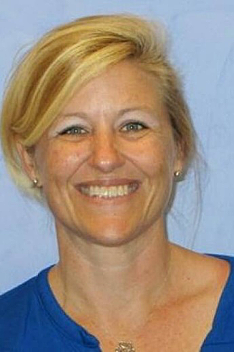Healing at Home: Eileen Branham

UF Health Shands HomeCare is a comprehensive home health and personal care agency devoted to helping patients maintain an independent lifestyle or continue therapy services from the comfort of their own home.
Eileen Branham is a licensed physical therapist with UF Health Shands HomeCare. She provides physical therapy, focusing on improving functional independence for patients who are homebound. In this Q&A, she discusses the benefits of home care and challenges professionals in the industry may face, including the impact of the COVID-19 pandemic. 
1. What kind of services do you provide at UF Health Shands HomeCare?
HomeCare is really one of the most personal connections in health care. I provide physical therapy and work to improve functional independence in the home. This includes helping patients safely get in/out of bed, move around in the home safely by either walking or in a wheelchair, improving strength and endurance for mobility, addressing balance deficits, establishing and progressing home exercise programs, and patient and family education regarding their diagnosis. Our ultimate goal is restoring patients to their maximal level of functional independence so they are prepared to return to the community. We also provide nursing services, occupational therapy, speech therapy, home health aide services to assist with bathing, and medical social work.
2. What conditions or diseases can be helped by your specialty or the services you provide?
The variety of conditions we treat is one of the best parts of HomeCare because patients with literally every diagnosis can benefit from HomeCare. We see patients post-surgery after joint replacements, cardiac surgery, multiple trauma, patients who are recovering from recent strokes, patients with varying neurological diagnoses — that includes Parkinson's disease, ALS, and dementia — patients who have fallen at home due to balance disorders, and patients with generalized weakness from recent illness. The variety of patients in home HomeCare is one of the things I love the most.
3. What do you enjoy most about your work?
Making an immediate impact on a patient's life. There is nothing more rewarding than helping a patient regain a lost function or helping to make it easier for a patient to remain in their home. The beauty of home care is helping patients where they live. We can help them modify their home environment to improve their independence and safety. Sometimes, it's as easy as suggesting moving a table or turning a shower chair around and instantly, their life is easier and safer.
4. What are some of the challenges of your work and how do you overcome them?
Many of the challenges are environmental or social; patients who don’t have access to equipment or have no consistent caregiver. Many times, we can overcome these challenges by helping patients to gain access to community resources or involving a social worker or a family member to assist. We can also help to improve a patient’s balance and mobility so they are then safer to access the community for shopping or medical appointments.
Other challenges could include the logistics of a location when scheduling patients. Traffic, especially during school drop-off or pickup, and weather can be challenging. Navigating dirt roads during heavy rain or a tropical storm is one example. More interestingly, challenges could include navigating errant livestock. I had a friend and colleague who was once chased by a cow and, last week, I had to negotiate around my patient’s pig!
5. Who can benefit from HomeCare?
Anyone who is homebound can benefit from HomeCare. We provide everything from nursing care, monitoring a patient’s vital signs, education on medications, physical therapy to address strength, endurance and mobility in home, and occupational therapy to improve independence with dressing, bathing and cooking. Additionally, speech therapy can improve swallowing, memory and cognition. Home health aides can assist with bathing, and social workers can help patients gain access to community resources.
6. How does your work have an impact on the patients?
Home health physical therapy is deeply personal. We work directly in patients’ home environments to make an instant impact on their function and safety in the home. Frequently, patients progress from requiring assistance with getting in and out of bed to being able to walk outside their homes, from needing assistance with dressing to be able to shower independently. Home health helps to keep patients safely in their homes.
7. How has the COVID-19 pandemic affected your patients and how you do your job?
Initially, patients were fearful of having anyone come into their home. Many requested to be discharged from services or refused services altogether, but soon patients became more comfortable having one provider come into their home, rather than having to go into a busier clinic with more exposure. We were able to monitor patients at home, reducing their exposure and still being able to safely provide services. We were able to update their doctors on their needs without the patient having to go out in the community. Additional challenges included the need to wear full protective gear in the middle of the summer in homes with little air conditioning, as well as the need for mask wearing with patients who are hard of hearing. It was definitely an adjustment. Currently, I do my job just as I always have, just in a mask and goggles and with additional screening questions at each visit.